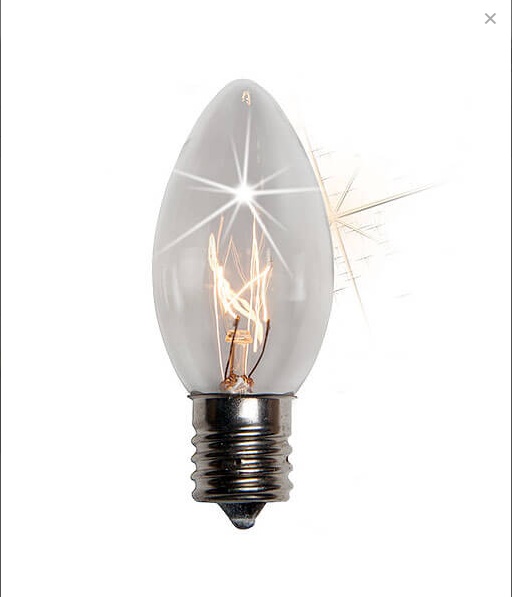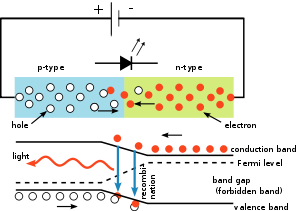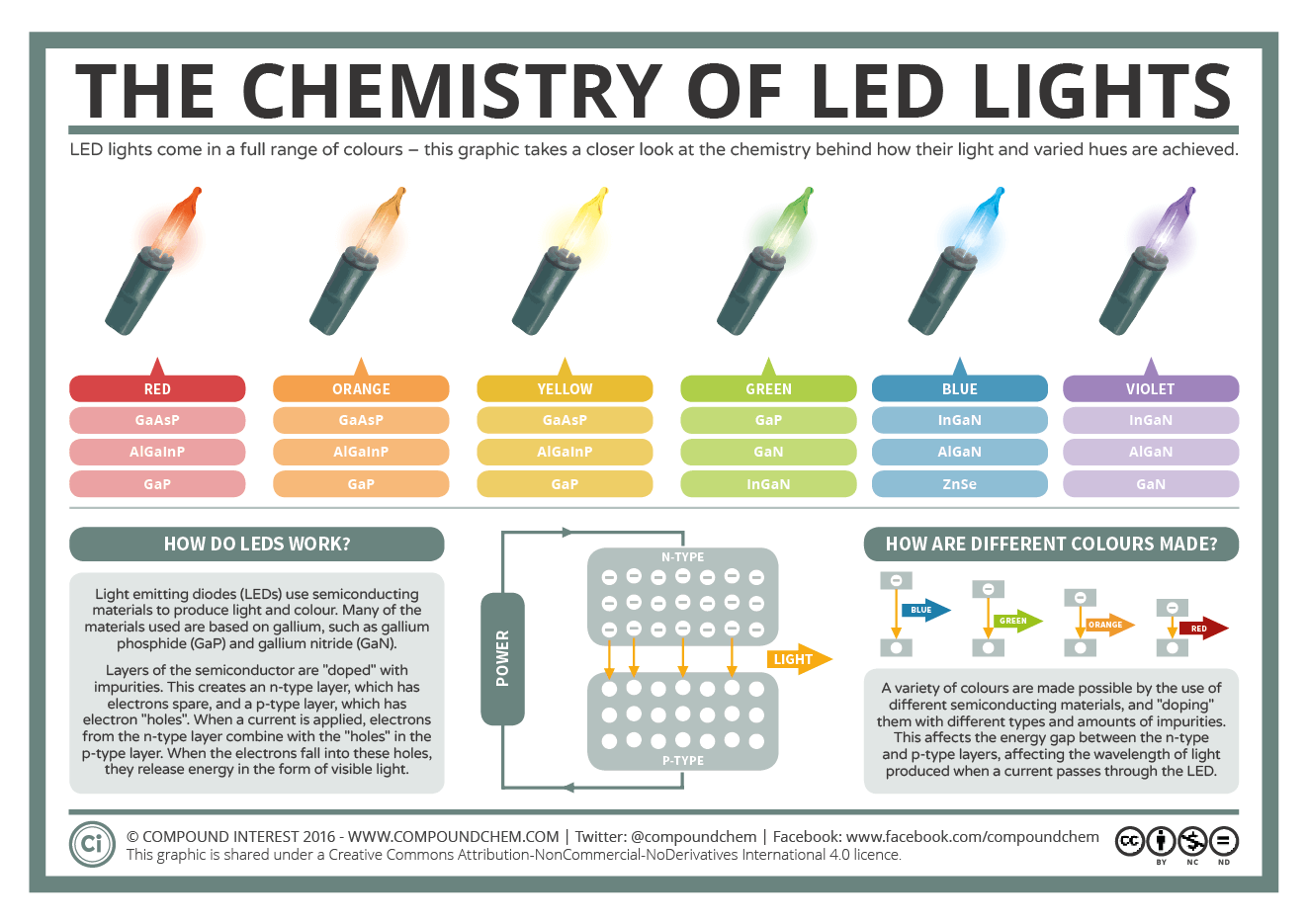Traditional Christmas Lights
As I mentioned above, the traditional "Christmas lights" were a glass bulb and bulky among other difficulties associated with them. One major hassle associated with setting up Christmas lights was the inspection of each light bulb on a string of lights in order to determine the culprit (faulty light bulb) before lighting the string. The laborious process was time consuming and resulted in great frustration. Although, after hanging Christmas lights up, the seasonal glow that is felt upon viewing them is inexplainable and worth all of the trouble.
How is the 'Glow' generated in old Christmas lights?
Traditional Christmas tree lights are incandescent light bulbs. Incandescent light bulbs have dominated the market over the last century. Here is a picture of an 'incandescent Christmas light bulb' shown below:
Source: 'The Christmas Lights Emporium'
As you can see, there is a wired that is asymmetrical (wounded irregularly) in winding in the center of the glass bulb. The operation of the bulb is described as follows:
The incandescent light bulb or lamp is a source of electric light that works by incandescence, which is the emission of light caused by heating the filament. They are made in an extremely wide range of sizes, wattages, and voltages.
As current travels through the wire, heat due to resistance is generated. Eventually, the heat is given off as light. There is still heat given off too. The warm glow produced by the incandescent light bulb remains to be a large challenge for Light-Emitting Diode makers. Although, the downside of using incandescent light bulbs is the heat loss associated with the operation. This could be problematic with lights on a Christmas tree. The heat from the incandescent light bulbs dries the Christmas tree out. In the extreme case, the heating could cause a fire.
The above explanation was part of the motivation to produce a more efficient light bulb that does not over heat with continued operation over a long period of time. Despite the move toward greater use of Light-Emitting Diode lights, the traditional incandescent light is still in wide use today.
Light-Emitting Diodes?
Technology has improved greatly with the introduction of the semiconductor. Other spin-off technologies are numerous (and I do not need to go into them). Anyways, typically, when the technology is discussed, the usual turn-off of attention is achieved on the part of the listener.
For example, new Christmas lights are made of "light-emitting diodes". The "wikipedia" contains the following definition of LED:
A light-emitting diode (LED) is a two-lead semiconductor light source. It is a p–n junction diode, which emits light when activated.[4] When a suitable voltage is applied to the leads, electrons are able to recombine with electron holes within the device, releasing energy in the form of photons. This effect is called electroluminescence, and the color of the light (corresponding to the energy of the photon) is determined by the energy band gap of the semiconductor.An LED is often small in area (less than 1 mm2) and integrated optical components may be used to shape its radiation pattern.[5]Appearing as practical electronic components in 1962,[6] the earliest LEDs emitted low-intensity infrared light. Infrared LEDs are still frequently used as transmitting elements in remote-control circuits, such as those in remote controls for a wide variety of consumer electronics. The first visible-light LEDs were also of low intensity and limited to red. Modern LEDs are available across the visible, ultraviolet, and infrared wavelengths, with very high brightness.Early LEDs were often used as indicator lamps for electronic devices, replacing small incandescent bulbs. They were soon packaged into numeric readouts in the form of seven-segment displays and were commonly seen in digital clocks.Recent developments in LEDs permit them to be used in environmental and task lighting. LEDs have many advantages over incandescent light sources including lower energy consumption, longer lifetime, improved physical robustness, smaller size, and faster switching. Light-emitting diodes are now used in applications as diverse as aviation lighting, automotive headlamps, advertising, general lighting, traffic signals, camera flashes, and lighted wallpaper. As of 2016, LEDs powerful enough for room lighting remain somewhat more expensive, and require more precise current and heat management, than compact fluorescent lamp sources of comparable output. They are, however, significantly more energy efficient and, arguably, have fewer environmental concerns linked to their disposal[citation needed].
As mentioned in the excerpt above, the LED has taken over the world to replace conventional light sources. One major reason is the large amount of energy saved by operating a LED compared to a traditional light bulb. Additionally, the LED Christmas light has a more durable coating and therefore is more stable and longer-lasting.
After reading the excerpt above (first paragraph), you might still have an issue with understanding the operation of the LED. In a recent article 'Compound Interests' titled "The Chemistry Of Lights" a simple explanation is put forth regarding the operation and design of the LED light. I am a big believer in "not re-inventing the wheel." Therefore, I love to share good explanations when I come across one.
Here is an excerpt regarding the operation and structure of the "light-emitting diode":
LEDs consist of two layers of semiconducting material. The layers are “doped” with impurities, which is to say that atoms of elements other than those originally in the semiconducting material are mixed in. This doping can create different types of layers: p-type layers and n-type layers. The n-type layer has a surplus of electrons, whereas the p-type layer has an insufficient number of electrons, and as such has what are referred to as electron ‘holes’: positions in atoms where an electron could be, but isn’t.When a current is applied to the LED, the electrons in the n-type layer and the electron ‘holes’ in the p-type layer are driven to an active layer between the two. When the electrons and electron ‘holes’ combine, energy is released, and this is seen as visible light. While this explains how light is produced, we have to look a little more closely at what’s going on to explain how different colours can be obtained.The colours obtained from LEDs are determined by the semiconducting materials used. As you can see in the graphic, there’s not just one material used for all of the different colours, but a range of possibilities. By using different materials, and adding different impurities to these materials, we can change the size of the band gap – that is, the size of the energy difference between the n-type layer and the p-type layer. The bigger this band gap, the shorter the wavelength of light produced by the LED. So for a red LED, a relatively small band gap is required. For blue LEDs, a larger band gap is needed.
Simply beautiful!
What does such a structure look like?
That is a trick question since the title of the blog post is Christmas lights! Below is a diagram taken from the 'wikipedia' page for 'LED':
Source: Inductiveload
The image above appears to resemble the traditional Christmas lights that are seen draped on houses and buildings around town. From the outside, this may be true. Although, on further inspection of the image above, there is no 'filament' as we saw above in the picture of the incandescent light bulb.
Why not?
According to the two descriptions of the Light-Emitting Diodes above, the structure is slightly different compared to an incandescent light bulb. Remember terms 'p-n junction' etc? A structure of an LED was taken from 'wikipedia' for clarity and is shown below:
Source: S-kei
According to the picture above, if the current (in the form of electrons) travels through the 'n-type' material toward the interface of the two types of material 'p-n junction' (in the center at the boundary of blue and yellow), the corresponding 'hole' moves toward the 'p-n junction' from the blue side. At the boundary layer, the two are combined. The combination of the electron and the positive 'hole' at the junction corresponds to light emitted.
Furthermore, if the 'p-n junction' is changed (made larger or smaller) the frequency of light (color) is changed too. Therefore, the light given off at the 'p-n junction' is precise. As I mentioned above, one downfall of the LED compared to the incandescents light bulb is the lack of 'glow'. The factor which gives the light a glow is the 'broad spectrum' of wavelengths (mixture of colors). In an LED, the interface -- i.e., 'p-n junction' is precisely tuned to give a sharp and very well defined frequency.
The above description was off of the site 'Compound Interests' whose design to display information is in the form of a 'poster' like the one shown below:
I chose to expand on the description given in this poster. The producer of the above infographic did such a great job, that I felt the need to share this with the public at large. This infographic went out to the science community last week. Here are some closing thoughts...
Conclusion...
The movement toward LED technology is on the rise. There are benefits toward using either type of Christmas light. LED lights give off a very well defined wavelength (or frequency) of light which results in a crisp sharp light. Whereas the traditional incandescent lights give off the warm 'glow' made up of a few different color components. Secondly, there is less heat given off with an LED light compared with the incandescent light bulb. Which results in greater efficiency. Finally....
As you travel the world during the holidays, hopefully, your viewing of the many different Christmas lights will be enhanced by this blog post. Try to identify which Christmas lights use LED technology and which use incandescent light technology. I hope that each and everyone of you have a wonderful and safe Christmas. Cheers!
Until Next time, Have a great day!

.svg/450px-LED%2C_5mm%2C_green_(en).svg.png)


No comments:
Post a Comment